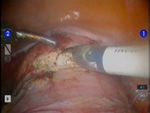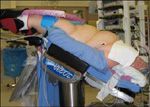Laparoscopic Surgery: Robotic Surgery Techniques
Traditional open gynecologic surgery using a large incision for access to the uterus and surrounding anatomy has for many years been the standard approach to many gynecologic procedures. Yet, with open surgery can come significant pain, trauma, a long recovery process, risk of adhesions, risk of incision breakdown, and threat to surrounding organs and nerves. For women facing gynecologic surgery, the period of pain, discomfort, and extended time away from normal daily activities that usually follows traditional surgery can understandably cause significant anxiety.
Traditional open gynecologic surgery using a large incision for access to the uterus and surrounding anatomy has for many years been the standard approach to many gynecologic procedures. Yet, with open surgery can come significant pain, trauma, a long recovery process, risk of adhesions, risk of incision breakdown, and threat to surrounding organs and nerves. For women facing gynecologic surgery, the period of pain, discomfort, and extended time away from normal daily activities that usually follows traditional surgery can understandably cause significant anxiety.
Fortunately, less invasive options are available. Some gynecologic procedures enable surgeons to access the target anatomy using a vaginal approach, which may not require an external incision. But for complex hysterectomies and other gynecologic procedures, a laparoscopic approach or robot-assisted surgery may be the most effective, least invasive treatment option.
Figure 1: Surgeon at console

Laparoscopic surgery has some limitations that are further overcome by the robotic approach. Some of the limitations of laparoscopy are reduced depth perception of the operative field caused by the use of 2D monitors; poor hand-eye coordination as a result of location of the monitor, variable amplification, mirrored movement, and misorientation; motion limitations due to trocar-induced invariant points, and reduced haptic feedback from the use of long and slender surgical instruments. Through tiny, 1-2 cm incisions, surgeons using robotic surgery (da Vinci Surgical System) can operate with greater precision and control using 180-degree hand movements, minimizing the pain and risk associated with large incisions while increasing the likelihood of a fast recovery and excellent clinical outcomes.
A wide variety of benign (noncancerous) conditions may affect a woman’s reproductive system, which consists of the uterus, vagina, ovaries, and fallopian tubes. Most of these conditions affect the uterus. Common types of gynecologic conditions, such as fibroids (noncancerous growths in the uterine wall), endometriosis (noncancerous growths of the uterine lining), or prolapse (falling or slipping of the uterus), can cause chronic pain and heavy bleeding as well as other disabling symptoms. When medication and other treatments are unable to relieve symptoms, hysterectomy-the surgical removal of the uterus-is often recommended to provide a more effective, definitive, long-term solution. In fact, this procedure is the second-most common surgical procedure for women in the United States, and an estimated one third of all US women will have a hysterectomy by age 60 years.
Figure 2a and 2b: Robotic instruments at work inside the patient abdomen


Robotic surgery is an emerging technology that is taking the surgical profession by storm. This article briefly lists gynecologic procedures applicable to robotics as well as some contraindications, tips for using the device in practice, and a short overview of training.
Gynecologic procedures applicable to robotics include:
Hysterectomy (total and subtotal)
Simple and complex (pelvic adhesive disease, endometriosis, fibroids)
Cancer Staging (cervical and endometrial)
Reproductive Surgery
Myomectomy
Endometriosis resection
Ovarian cystectomy or transposition
Tubal reversal or reanastomosis
Muellerian anomalies
Urogynecologic Surgery
Sacrocolpopexy
Uterosacral suspension
Benefits of Robotic Surgery
•Three-dimensional viewing for optimum viewing within the operative site.
•Seven degrees of instrument movements allowing the surgeon to reach difficult spaces.
•Ninety degrees of articulation making movements easier.
•Intuitive movements and ergonomics providing increased precision, control, and range of microinstruments.
•Tremor filtration, thus decreasing error.
•Comfortable seating for surgeon, thereby increasing surgeon longevity.
•Robotics minimizes need for multiple assistants due to improved access to and manipulation of organs, tissues, and nerves.
• Telesurgery and telementoring making remote surgery a possibility
When to Avoid Robotic Surgery
Physicians should avoid using robotic surgery in the following instances:
• If the patient has a medical condition such as cardiopulmonary disease, where risks of general anesthesia or the increased intraperitoneal pressure associated with laparoscopy or robotic surgery is unacceptable.
• If morcellation is likely to be required and uterine malignancy is known or suspected.
• If Trendellenberg positioning is dangerous or unacceptable for a particular patient.
• In circumstances where anatomy is so distorted that a minimally invasive approach is not deemed safe.
• If adequate training is not acquired by providers or trained providers are not present or accessible. Surgeons without the requisite training and skills required for the safe performance of such procedures should enlist the aid of colleagues who do or should refer patients to such individuals for their surgical care (see AAGL position statement).
• If the patient must not be in a fixed position for a given length of time.
One of the disadvantages to robotic surgery is that it is a new technology and therefore its uses and efficacy have not yet been well established. To date, mostly studies of feasibility have been conducted, and almost no long-term follow-up studies have been performed. Many procedures will also have to be redesigned to optimize the use of robotic arms and to increase efficiency.
Another disadvantage of these systems is their cost. With a price tag of a million dollars, the robotic device cost may be nearly prohibitive for some hospitals. Another question remains as to the status of upgrades and how often? As they gain widespread multidisciplinary use, these questions may become easier to answer.
The size of these systems is another potential drawback, with large footprints and relatively cumbersome robotic arms. One of the potential disadvantages identified is a lack of compatible instruments and equipment, which is being addressed slowly. Most of the disadvantages identified will be remedied with time and improvements in technology.
Using Robotic Devices in Practice
Equipment apparatus size, draping and docking, and costs are some of the challenges of robotic surgery. Functional challenges include lack of haptic feedback, limited ability to exchange instruments, limited instrumentation, surgeon’s distance from the operative field and additional preparatory time.
It is good practice to position the patient with arms padded and tucked on side, gel pads to prevent sliding and securing of shoulders and breasts to optimize ventilation (Figure 3).
Figure 3. Proper positioning of a patient for robotic surgery.

Prior to surgery, bowel prep helps with both bowel mobilization and prevention of injuries. This also facilitates having less steep Trendelenberg position during surgery. I recommend a cleaning preparation with polyethylene glycol that just debulks the rectum and sigmoid.
During the procedure, proper port placement is the key to successful outcome (Figure 4). Assess the surgical field and place ports accordingly. A midline port for the camera and two instrument ports on either side, at least 10 cm away, is recommended so that instruments do not clash. Then one or two additional assistant ports can be placed superior to and in between the camera and instrument ports. Never move instruments outside the visual field; slow and deliberate movements are advisable.
Figure 4: Proper port placement


Training
There is a 4-stage learning curve to using robotic devices. The first stage is to achieve basic proficiency with the operation of the robotic device. The second stage involves achieving proficiency with the basic technique in “optimal candidates.” The third stage is to approach more challenging cases with pelvic adhesive disease, large uteri, and obesity. The fourth and final stage is to modify the technique to improve proficiency and outcomes.
The training consists of an online computer course, followed by a laboratory training that is provided by the company. Then the surgeon can go and see some cases being performed followed by proctored cases, depending on the level of prior laparoscopic training and experience with certain procedures. I am a certified daVinci proctor and my advice for surgeons is to ask for more proctored cases until they feel they are proficient and can perform the surgery without supervision and guidance. The literature suggests 20-75 cases, stating that training is impacted by case volume, patient selection, knowledge of anatomy, and technical prowess.Conclusion
Although still in its infancy, robotic surgery has already proven itself to be of great value, particularly in areas inaccessible to conventional laparoscopic procedures. It remains to be seen, however, if robotic systems will replace conventional laparoscopic instruments in less technically demanding procedures. The idea is not to replace laparoscopic surgery for simpler and smaller procedures, rather use the technology for more technically challenging procedures, suture intensive procedures, and difficult access area procedures.
In any case, robotic technology is set to revolutionize surgery by improving and expanding laparoscopic procedures, advancing surgical technology, and bringing surgery into the digital age. Furthermore, it has the potential to expand surgical treatment modalities beyond the limits of human ability. Whether the benefit of its usage overcomes the cost to implement it remains to be seen and much remains to be worked out. Although feasibility has largely been shown, more prospective randomized trials evaluating efficacy and safety must be undertaken. Further research must evaluate cost effectiveness or a true benefit over conventional therapy for robotic surgery to take full root.
Key Studies of Robotic Procedures
1.Ko EM, Muto MG, Berkowitz RS, Feltmate CM. Robotic versus open radical hysterectomy: a comparative study at a single institution. Gynecol Oncol. 2008 Dec;111(3):425-30.
2.Piquion-Joseph JM, Navar A, Ghazaryan A, et al. Robot-assisted gynecological surgery in a community setting. J Robotic Surgery. 2009;3:61-64.
3.DeNardis SA, Holloway RW, Bigsby GE, et al. Robotically assisted laparoscopic hysterectomy versus total abdominal hysterectomy and lymphadenectomy for endometrial cancer. Gynecol Oncol. 2008;111:412-417.
4.Payne TN, Dauterive FR. A comparison of total laparoscopic hysterectomy to robotically assisted hysterectomy: surgical outcomes in a community practice. J Minim Invasive Gynecol. 2008;15(3): 286-291.
5.Boggess JF, Gehrig PA, Cantrell L, et al. A comparative study of 3 surgical methods for hysterectomy with staging for endometrial cancer: robotic assistance, laparoscopy, laparotomy. Am J Obstet Gynecol. 2008 Oct;199(4):360.e1-9.
6.Bell MC, Torgerson J, Seshadri-Kreaden U, et al. Comparison of outcomes and cost for endometrial cancer staging via traditional laparotomy, standard laparoscopy and robotic techniques. Gynecol Oncol. 2008 Dec;111(3):407-411. Epub 2008 Oct 1.
7.Advincula AP, Song A, Burke W, Reynolds RK. Preliminary experience with robot-assisted laparoscopic myomectomy. J Am Assoc Gynecol Laparosc. 2004 Nov;11(4):511-518.
References:
Resources
1. Berlinger NT. Robotic surgery-squeezing into tight places. N Engl J Med. 2006; 354:2099-2101.
2. Reynolds RK, Advincula AP. Robot-assisted laparoscopic hysterectomy: technique and initial experience. Am J Surg. 2006;191(4):555-560.
3. Hockstein NG, Gourin CG, Faust RA, Terris DJ. A history of robots: from science fiction to surgical robotics. J Robotic Surgery. 2007;1(2):113-118.
4. Payne TN, Dauterive FR. A comparison of total laparoscopic hysterectomy to robotically assisted hysterectomy: surgical outcomes in a community practice. J Minim Invasive Gynecol. 2008;15:286-291.
5. Advincula AP, Song A, Burke W, Reynolds RK. Preliminary experience with robot-assisted laparoscopic myomectomy. J Am Assoc Gynecol Laparosc. 2004; 11(4):511-518.
6. Lenihan FR Jr, Kovanda C, Seshadri-Kreaden U. What is the learning curve for robotic assisted gynecologic surgery? J Minim Invasive Gynecol. 2008;15:589-594.
7. Shashoua AR, Gill D, Locher SR. Robotic-assisted total laparoscopic hysterectomy versus conventional total laparoscopic hysterectomy. J Soc Laparoendosc Surg. 2009;13:364-369.
8. Payne TN, Dauterive FR. Robotically assisted hysterectomy: 100 cases after the learning curve. J Robotic Surg. 2010;4:11-17.
9. Elliott DS, Krambeck AE, Chow GK. Long-term results of robotic assisted laparoscopic sacrocolpopexy for the treatment of high grade vaginal vault prolapse. J Urol. 2006;176:655.
10. Kolata G. Results unproven, robotic surgery wins converts. The New York Times: February 13, 2010.
11. Xin H, Zelek JS, Carnahan H.Laparoscopic surgery, perceptual limitations and force: a review. Accessed August 29, 2011.
